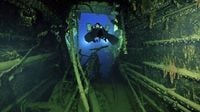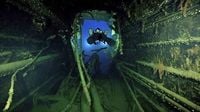More than a century after the HMHS Britannic, sister ship to the legendary Titanic, vanished beneath the waves of the Aegean Sea, a team of professional divers has managed to recover artefacts from its wreck for the very first time. The operation, which took place in May 2025 but was only publicly announced this week by the Greek Culture Ministry, marks a historic milestone in maritime archaeology and the ongoing fascination with the White Star Line’s Olympic-class liners.
The Britannic, launched in 1914 at the famed Harland & Wolff shipyard in Belfast, was the third and final vessel in the Olympic-class trio, alongside the RMS Titanic and RMS Olympic. While the Titanic’s tragic maiden voyage in 1912 is etched into global memory, the Britannic’s own fate was equally dramatic, albeit less well-known. Requisitioned by the British Admiralty during World War I, the Britannic was transformed into a hospital ship, tasked with ferrying wounded soldiers from the Middle East back to the United Kingdom.
On November 16, 1916, during its sixth mission as a hospital ship, the Britannic struck a German mine off the Greek island of Kea. The ship, measuring 882 feet in length—identical to the Titanic, though with a slightly broader beam—sank in less than an hour. Out of the 1,065 people on board, 30 lost their lives, most tragically when two lifeboats were drawn into the ship’s massive propellers. The rest escaped in 35 lifeboats, a testament to improved safety measures since the Titanic disaster.
According to the Greek Culture Ministry and as reported by BBC and AP, the recent recovery operation was no small feat. An 11-member team of professional deep-sea divers, equipped with closed-circuit rebreather technology, descended more than 120 meters (around 394 feet) to the wreck. The mission was organized by British maritime historian Simon Mills, founder of the Britannic Foundation and current owner of the ship’s wreck. Mills’ long-standing dedication to preserving Britannic’s legacy played a crucial role in the success of the expedition.
The divers faced formidable challenges: strong underwater currents, near-freezing temperatures, and low visibility made every move perilous. "Conditions at the wreck site were particularly challenging due to currents, depth, and low visibility," the recovery team noted, as cited by Greek authorities. Despite these obstacles, the team managed to recover a trove of artefacts that had lain untouched for more than a hundred years.
Among the items brought to the surface were the ship’s lookout bell, a portside navigation lamp, a pair of passenger observation binoculars, ceramic tiles from the Turkish baths, and various pieces of equipment from both first- and second-class cabins. These artefacts were carefully lifted using air bags, then secured in containers and promptly cleaned of marine organisms to prevent further deterioration. Some objects identified in the original recovery plan could not be retrieved—either due to their fragile state or because they were inaccessible within the wreck’s twisted remains.
Once recovered, the artefacts were transported to the laboratories of the Ephorate of Underwater Antiquities (EUA) in Athens. There, conservation experts are now meticulously working to stabilize and preserve each item. The process, according to the Greek Culture Ministry, involves removing marine encrustations and halting the corrosive effects of long-term submersion in saltwater. Conservation work is expected to continue for several months, if not longer, given the artefacts’ delicate condition and historical importance.
The ultimate destination for these relics is the forthcoming National Museum of Underwater Antiquities in Piraeus, Greece, which is currently under construction. The museum will feature a dedicated section on World War I maritime history, with the Britannic artefacts taking center stage. For historians and the public alike, the chance to view these objects—silent witnesses to a bygone era—will offer a tangible connection to the stories of those who sailed aboard the great liners.
The operation’s significance extends beyond the artefacts themselves. As the Associated Press highlighted, this is the first time that objects have been retrieved from the Britannic’s resting place, making the discovery both archaeologically and historically significant. The Britannic, once hailed as the largest and safest of the Olympic-class liners, has long been overshadowed by her ill-fated sister ship. Yet her story, from her hurried conversion to a hospital ship to her sudden demise in wartime, reflects the broader upheavals of the early 20th century.
The Titanic, of course, remains the most famous of the trio, having sunk on April 14, 1912, after striking an iceberg in the North Atlantic. Of the 2,224 people on board, 1,635 perished—a tragedy that led to sweeping changes in maritime safety regulations. The RMS Olympic, meanwhile, enjoyed a long and successful career, serving as both a passenger liner and a troopship before being retired and scrapped in 1935.
The Britannic’s sinking, while less catastrophic in terms of loss of life, was nonetheless a sobering reminder of the dangers faced by even the most advanced ships of the era. The fact that so many passengers survived was due in part to the lessons learned from the Titanic disaster—lifeboat drills, improved evacuation procedures, and more lifeboats on board. As Simon Mills and his team have demonstrated, the Britannic’s legacy continues to evolve, offering new insights with every discovery.
Looking ahead, the recovered artefacts promise to deepen our understanding of life aboard the Britannic and, by extension, the world of early 20th-century ocean liners. They also serve as a poignant memorial to those who lost their lives in service during World War I. As the National Museum of Underwater Antiquities prepares to open its doors, the story of the Britannic will finally take its rightful place alongside those of her more famous siblings—a story of innovation, tragedy, and enduring human curiosity.






